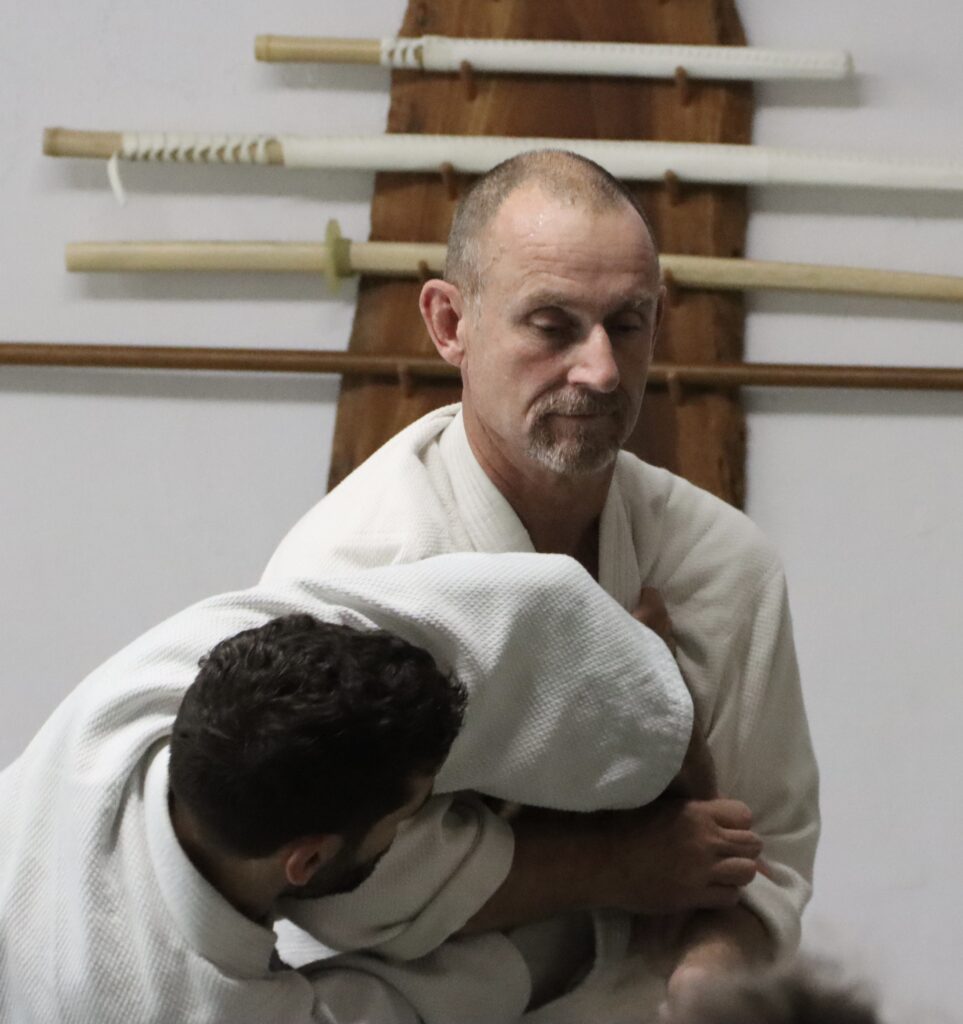Daniel Kempling, Pacific Coast Aikikai
O-Sensei is quoted to have said that “The essence of the Art of Peace is to cleanse your heart of maliciousness, to get in tune with your environment, and to clear your path of all obstacles and barriers.”
I first read these words some 40 years ago during my first year of training. My understanding then of the first phrase “to cleanse your heart of maliciousness” seemed to me simple: don’t act out of cruelty. Considering myself a kind fellow, I figured I could pretty much skip that step and move on to the next directives. But in the decades since then, my understanding of this maliciousness has expanded to include malice towards the moment, an inherent rejection of any circumstance that arises in a way contrary to my preferences.
Malice engenders resistance. Resistance, unchecked, leads to tension and fixation, fevered thoughts and frantic action.
In my research into this life through the lens of Aikido it has become clear that dropping unnecessary tension is one of the primary objectives. I further understand that to evolve in Aikido, by its very nature, demands that we cultivate the same principles and practices in our daily lives. In other words, this cleansing our hearts of maliciousness must become our everyday jeans, not a tuxedo or gown worn only for a special occasion.
How might we recognize this malice in our lives and training? Constricted posture, upward-rising muscular tension and loss of breath rhythm are the physical cues; fevered thinking laden with speculative, scary stories marks the mental state.
I had an insight into this phenomenon one day, a few years back, at my ranch in northern Alberta. It was a late March day, one where the six inches of snow from a few days ago was beginning to melt into that special mix of muddy, boot-sucking gumbo. I had some repair work to do down by the barn and so loaded all my tools into a wheelbarrow to ford my way the couple hundred meters through the muck from the tool shed to the barn. As I began to plug in and lay out I realized that I had forgotten my framing square back at the shed. After uttering a heartfelt expletive, I headed back to the tool shed, trudging through the muck, head down, vexed and muttering.
For whatever reason, my inner voice chirped up, asking “Hey, buddy, you going to trudge like a whipped horse? Maybe you want to give some quality to your walk.” Now, having cultivated this well-earned grump, I was a bit loath to give it up before I arrived at my preferred circumstances. Nonetheless, I shifted my attention to the quality of my walking, raised my chin to the horizon and made a study of the most efficient way to extract my boots from the muck (hello, iliopsoas, that’s what you do for a living!) Not surprisingly, the bandwidth I’d dedicated to self-loathing was now allocated to my goal of quality of execution, and the fevered mental state soon subsided.

In my Aikido keiko, I similarly strive to meet each encounter without malice. I find that the most challenging arena for this endeavor is in taking dynamic ukemi. And Chiba Sensei, bless his heart, made the pathway available to us through the invitation to ride the white water that was his budo. I found the process terrifying, frustrating and absolutely captivating. As in koan training, Sensei’s hand blades closed door after door. “Not that. Not that!”
There came a point where none of my fear-based misery management techniques were sufficient to the task. The breakthrough came in a surprising way, through a change in emotional ‘tuning’ rather than through any particular technical adaptation. On a day of training where everything else in my life seemed like it was going down the toilet, I had run out of damns to give. I attacked Sensei as never before, truly trying to strike him for the first time. And, for the first time, I stopped fighting the waves and pushed into the all-consuming intensity of the surfing experience. This was not a ‘salvation experience’, wherein I never had to struggle as before, but I knew then that I had the scent of the trail.
Carl Jung once wrote, “What you resist, persists.” Resisting ingrained tendencies like reactive fear and anger leads to endless cognitive tail-chasing. The first moments in this reactive state are akin to a strike from your blind side. It is shocking. It is recognizing the attendant tension-filled body states that arise thereafter that gives us the signal to accept, re-set and integrate. Take a deep breath, push the out breath longer than is habitual. Push your heart into your immediate environment, extend your crown like an antenna. Check your jaw and shoulders for tension. Get on the balls of your feet. Give quality to the process at hand, striving for clarity and efficiency. If you’re frustrated, be frustrated in detail.
These somatic tools are cultivated to more accurately survey your environment. With these tools applied consistently, the heart does indeed cleanse itself, allowing us to more accurately get in tune with our environments, both interior and exterior. It is from this attunement that our spirits reveal the obstacles and barriers between us and our birthright, fluency in the Art of Peace.


This is excellent Sensei! I needed to hear this today. Thank you for sharing.
Lovely awareness of environment and body mind connections. Thanks so much for the reminders of how we can be “malicious” in our lack of living in the moment.